the Great Wall
- 格式:doc
- 大小:40.00 KB
- 文档页数:4
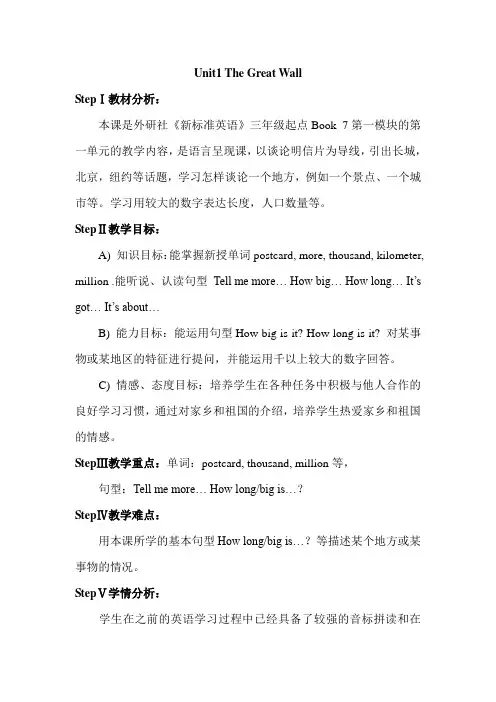
Unit1 The Great WallStepⅠ教材分析:本课是外研社《新标准英语》三年级起点Book 7第一模块的第一单元的教学内容,是语言呈现课,以谈论明信片为导线,引出长城,北京,纽约等话题,学习怎样谈论一个地方,例如一个景点、一个城市等。
学习用较大的数字表达长度,人口数量等。
StepⅡ教学目标:A) 知识目标:能掌握新授单词postcard, more, thousand, kilometer, million .能听说、认读句型Tell me more… How big… How long… It‟s got… It‟s about…B) 能力目标:能运用句型How big is it? How long is it? 对某事物或某地区的特征进行提问,并能运用千以上较大的数字回答。
C) 情感、态度目标:培养学生在各种任务中积极与他人合作的良好学习习惯,通过对家乡和祖国的介绍,培养学生热爱家乡和祖国的情感。
StepⅢ教学重点:单词:postcard, thousand, million等,句型:Tell me more… How long/big is…?StepⅣ教学难点:用本课所学的基本句型How long/big is…?等描述某个地方或某事物的情况。
StepⅤ学情分析:学生在之前的英语学习过程中已经具备了较强的音标拼读和在教师同伴的帮助下泛读课文的能力,在这学期的课文教学中我将侧重于帮助学生真正理解课文,进一步学习归纳概括,完成各种学习任务,提高英语的综合语言运用能力,同时注重培养学生积极与他人交流合作,相互学习,共同完成任务的能力,乐于运用英语进行表达和交流的能力StepⅥ教学方法:《英语课程标准》提倡任务型教学模式,要求尽量创造真实的语言环境,引导学生在任务情境中学习语言,进行探究性学习。
立足于此,我注重教学内容与学生生活相结合,实现“学以致用”的教学目标。
同时我适时、合理地借助多媒体来优化教学过程,以激发学生的学习兴趣,提高学生的信心。
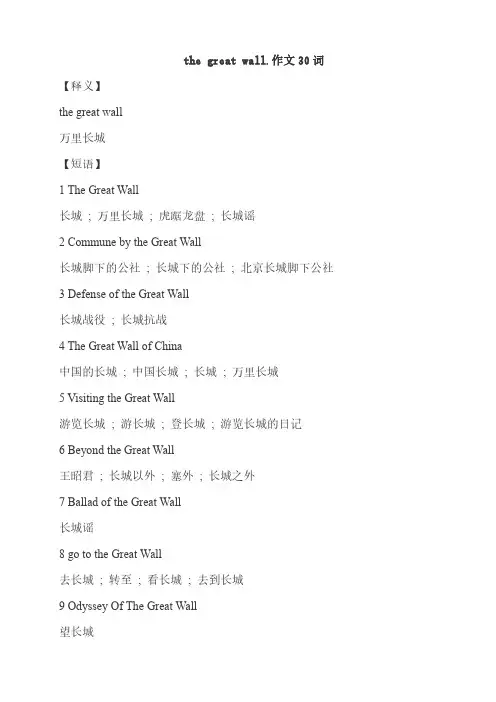
the great wall.作文30词【释义】the great wall万里长城【短语】1The Great Wall长城;万里长城;虎踞龙盘;长城谣2Commune by the Great Wall长城脚下的公社;长城下的公社;北京长城脚下公社3Defense of the Great Wall长城战役;长城抗战4The Great Wall of China中国的长城;中国长城;长城;万里长城5Visiting the Great Wall游览长城;游长城;登长城;游览长城的日记6Beyond the Great Wall王昭君;长城以外;塞外;长城之外7Ballad of the Great Wall长城谣8go to the Great Wall去长城;转至;看长城;去到长城9Odyssey Of The Great Wall望长城10The Great Wall Sheraton Hotel北京喜来登长城饭店;长城饭店【例句】1Let's walk on the Great Wall.Let's watch a shadow puppet play.我们去长城上走一走吧。
我们去看一场皮影戏吧。
2Between221and210B.C.,he started the building of the Great Wall.公元前221年至公元前210年,他开始修建长城。
3There is a famous Chinese saying:one is not a true man unless he climbs up the Great Wall.中国有句名言:不到长城非好汉。
4It's a picture of the Great Wall.这是一张长城的照片。
5They also like to visit the Great Wall.他们还喜欢游览长城。
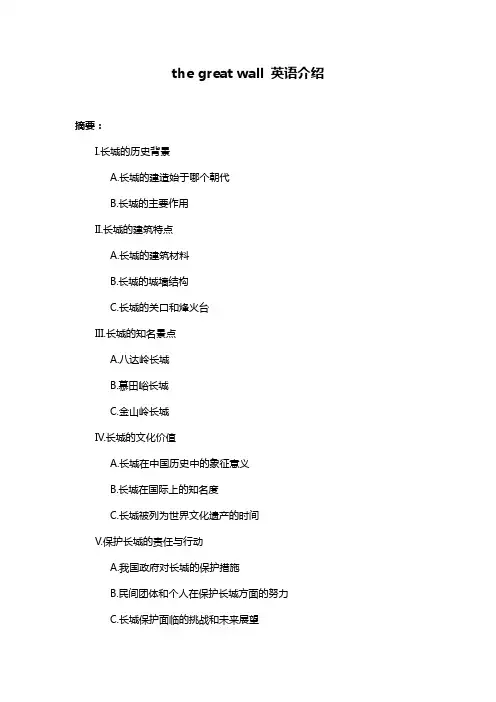
the great wall 英语介绍摘要:I.长城的历史背景A.长城的建造始于哪个朝代B.长城的主要作用II.长城的建筑特点A.长城的建筑材料B.长城的城墙结构C.长城的关口和烽火台III.长城的知名景点A.八达岭长城B.慕田峪长城C.金山岭长城IV.长城的文化价值A.长城在中国历史中的象征意义B.长城在国际上的知名度C.长城被列为世界文化遗产的时间V.保护长城的责任与行动A.我国政府对长城的保护措施B.民间团体和个人在保护长城方面的努力C.长城保护面临的挑战和未来展望正文:I.长城的历史背景长城,作为世界文化遗产之一,是中国古代的军事防御工事。
它的建造始于春秋战国时期,但最有名的长城是明朝时期建造的。
明朝时期的长城东起鸭绿江,西至嘉峪关,全长约8,850 公里。
长城的主要作用是抵御外敌入侵,保卫边疆安全。
II.长城的建筑特点长城的建筑材料主要是砖、石和土。
在山区地段,长城依山势而建,墙体较为陡峭。
在平原地段,长城则采用夯土筑成,较为平坦。
长城的城墙结构包括城墙、城垛、女儿墙等部分。
长城沿线还设有关口和烽火台,用于传递战争信息和预警。
III.长城的知名景点长城有很多著名的旅游景点,其中最具代表性的有八达岭长城、慕田峪长城和金山岭长城。
八达岭长城是长城最著名的景区,吸引了大量国内外游客。
慕田峪长城景色秀美,被称为“秀美之最”。
金山岭长城保存较为完整,具有较高的历史和文化价值。
IV.长城的文化价值长城在中国历史中具有重要的象征意义,代表了中华民族的勇气和智慧。
在国际上,长城也享有极高的知名度,成为中国的象征之一。
1987 年,长城被联合国教科文组织列为世界文化遗产,进一步彰显了其文化价值。
V.保护长城的责任与行动我国政府高度重视长城的保护工作,采取了一系列措施,如设立专门的长城保护机构、开展长城维修和保护工程等。
同时,民间团体和个人也在积极参与保护长城的行动,如开展长城志愿服务、捐赠长城保护资金等。
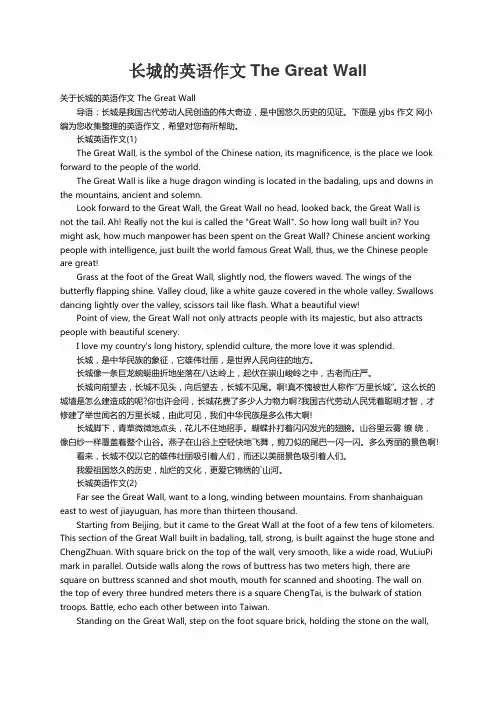
长城的英语作文The Great Wall关于长城的英语作文The Great Wall导语:长城是我国古代劳动人民创造的伟大奇迹,是中国悠久历史的见证。
下面是yjbs 作文网小编为您收集整理的英语作文,希望对您有所帮助。
长城英语作文(1)The Great Wall, is the symbol of the Chinese nation, its magnificence, is the place we look forward to the people of the world.The Great Wall is like a huge dragon winding is located in the badaling, ups and downs in the mountains, ancient and solemn.Look forward to the Great Wall, the Great Wall no head, looked back, the Great Wall isnot the tail. Ah! Really not the kui is called the "Great Wall". So how long wall built in? You might ask, how much manpower has been spent on the Great Wall? Chinese ancient working people with intelligence, just built the world famous Great Wall, thus, we the Chinese people are great!Grass at the foot of the Great Wall, slightly nod, the flowers waved. The wings of the butterfly flapping shine. Valley cloud, like a white gauze covered in the whole valley. Swallows dancing lightly over the valley, scissors tail like flash. What a beautiful view!Point of view, the Great Wall not only attracts people with its majestic, but also attracts people with beautiful scenery.I love my country's long history, splendid culture, the more love it was splendid.长城,是中华民族的象征,它雄伟壮丽,是世界人民向往的地方。
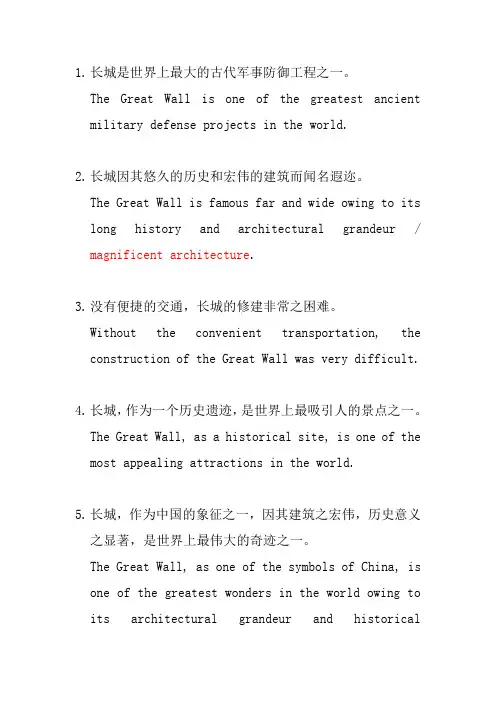
1.长城是世界上最大的古代军事防御工程之一。
The Great Wall is one of the greatest ancient military defense projects in the world.2.长城因其悠久的历史和宏伟的建筑而闻名遐迩。
The Great Wall is famous far and wide owing to its long history and architectural grandeur / magnificent architecture.3.没有便捷的交通,长城的修建非常之困难。
Without the convenient transportation, the construction of the Great Wall was very difficult.4.长城,作为一个历史遗迹,是世界上最吸引人的景点之一。
The Great Wall, as a historical site, is one of the most appealing attractions in the world.5.长城,作为中国的象征之一,因其建筑之宏伟,历史意义之显著,是世界上最伟大的奇迹之一。
The Great Wall, as one of the symbols of China, is one of the greatest wonders in the world owing to its architectural grandeur and historicalsignificance.长城,作为中国的象征之一,不仅是中国的奇迹,也是整个世界的奇迹。
As one of the symbols of China, the Great Wall is a wonder not only to China but to the whole world as well.它始建于春秋战国时期。
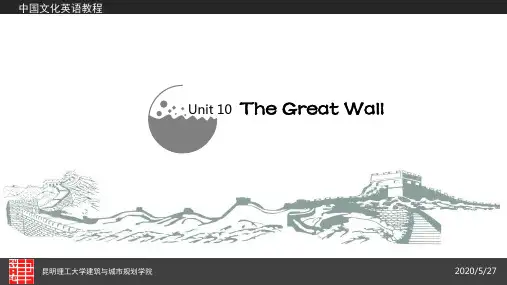
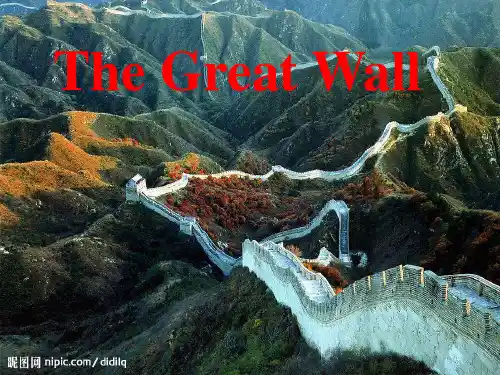
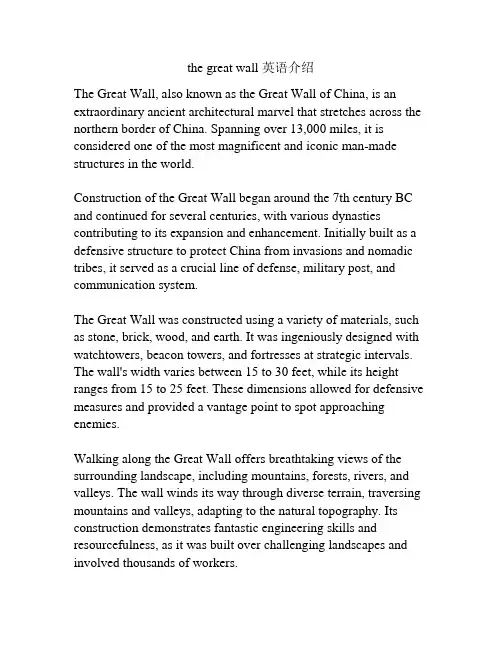
the great wall 英语介绍The Great Wall, also known as the Great Wall of China, is an extraordinary ancient architectural marvel that stretches across the northern border of China. Spanning over 13,000 miles, it is considered one of the most magnificent and iconic man-made structures in the world.Construction of the Great Wall began around the 7th century BC and continued for several centuries, with various dynasties contributing to its expansion and enhancement. Initially built as a defensive structure to protect China from invasions and nomadic tribes, it served as a crucial line of defense, military post, and communication system.The Great Wall was constructed using a variety of materials, such as stone, brick, wood, and earth. It was ingeniously designed with watchtowers, beacon towers, and fortresses at strategic intervals. The wall's width varies between 15 to 30 feet, while its height ranges from 15 to 25 feet. These dimensions allowed for defensive measures and provided a vantage point to spot approaching enemies.Walking along the Great Wall offers breathtaking views of the surrounding landscape, including mountains, forests, rivers, and valleys. The wall winds its way through diverse terrain, traversing mountains and valleys, adapting to the natural topography. Its construction demonstrates fantastic engineering skills and resourcefulness, as it was built over challenging landscapes and involved thousands of workers.Besides its military significance, the Great Wall also served as a symbol of China's ancient civilization and cultural heritage. It represents the resilience, tenacity, and unity of the Chinese people over centuries. The wall's historical and cultural significance has been acknowledged by UNESCO, which designated it as a World Heritage Site in 1987.Visiting the Great Wall offers a unique opportunity to immerse oneself in Chinese history and learn about one of the most monumental construction projects in human history. Many sections of the wall are open to visitors, providing the chance to walk along its ancient ramparts, explore watchtowers, and marvel at the stunning views.In summary, the Great Wall of China is a testament to China's rich history, architectural brilliance, and cultural heritage. Its colossal scale, strategic design, and picturesque location make it a must-visit destination for tourists from around the world.。
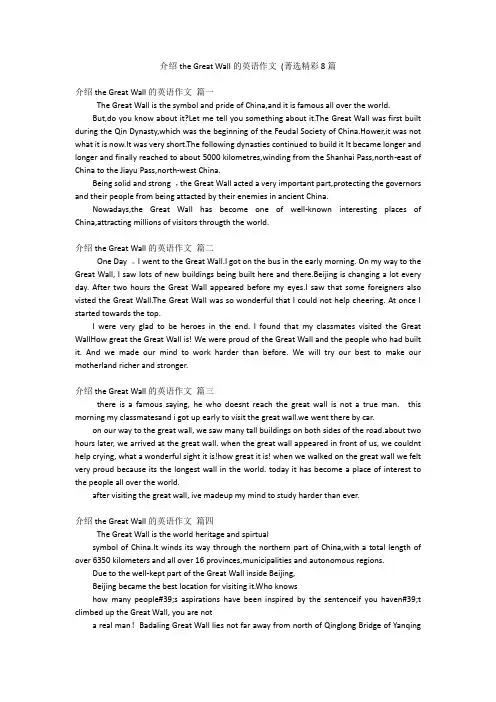
介绍the Great Wall的英语作文(菁选精彩8篇介绍the Great Wall的英语作文篇一The Great Wall is the symbol and pride of China,and it is famous all over the world.But,do you know about it?Let me tell you something about it.The Great Wall was first built during the Qin Dynasty,which was the beginning of the Feudal Society of China.Hower,it was not what it is now.It was very short.The following dynasties continued to build it It became longer and longer and finally reached to about 5000 kilometres,winding from the Shanhai Pass,north-east of China to the Jiayu Pass,north-west China.Being solid and strong ,the Great Wall acted a very important part,protecting the governors and their people from being attacted by their enemies in ancient China.Nowadays,the Great Wall has become one of well-known interesting places of China,attracting millions of visitors througth the world.介绍the Great Wall的英语作文篇二One Day 。

the great wall 阅读理解
《长城》(The Great Wall)是漫画家张茵的作品,于2019年在中国出版。
该作品是一部侦探小说,讲述了二十年前在长城上发生的一宗离奇案件与现在的一系列神秘事件之间的关联。
故事的主人公是一位年轻的女警察刘晓,她在调查一桩二十年前的长城失踪案时意外发现了相关的线索。
在二十年前,一群登上长城的游客突然失踪,就像融化在空气中一样。
然而,当地警方对此案束手无策,于是将其归类为未解之谜。
现在,刘晓接手了这个案件,并意识到二十年前的案件与当前发生的一系列神秘事件有关。
她发现被困在长城之间的人们突然消失,而且每次消失的人都与二十年前失踪的游客相关。
同时,刘晓还遇到了一位神秘的长城守护者,他看似年轻但已经活了几百年。
通过与长城守护者的合作,刘晓揭开了一个关于长城的秘密组织的阴谋:这个组织利用长城通向另一个世界的特殊能力,通过绑架和操纵人类来满足他们的目的。
而二十年前的失踪游客正是他们的试验品。
在最终的追逐和战斗中,刘晓揭示了这个组织的真正目的,并成功将其摧毁。
与此同时,她也与长城守护者建立了深厚的感情。
《长城》通过一个神秘的案件为读者呈现了一段恢宏的中国历史背景,并融入了侦探与惊悚元素。
故事中的刘晓和长城守护
者形象鲜明,情节紧凑,引人入胜。
这部作品获得了广大读者的喜爱,并成为了当年的畅销书之一。
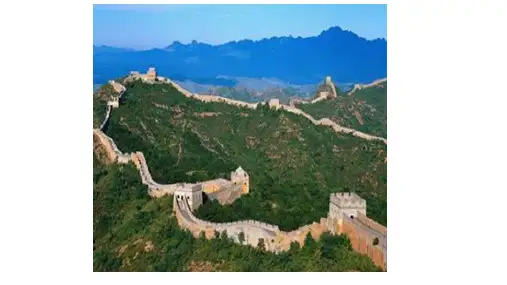
the great wall 阅读理解The Great Wall: Exploring China's Majestic WonderAs one of the world's most famous landmarks, the Great Wall of China has captured the imagination of people around the globe. Stretching for over 13,000 miles across the northern part of the country, this ancient architectural marvel has stood as a symbol of China's rich history and heritage for centuries. In this article, we will delve into the fascinating world of the Great Wall, exploring its history, significance, and unique features.1. Historical BackgroundThe construction of the Great Wall can be traced back to the 7th century BC, during the Warring States period in China. Initially built as separate walls by various states, it was Emperor Qin Shi Huang who unified these defensive structures into one colossal barrier to protect the country from invading forces. The majority of the existing wall was built during the Ming Dynasty (1368-1644) to fortify the northern border and maintain territorial integrity.2. Structure and FeaturesThe Great Wall, known as "Chang Cheng" in Chinese, is a remarkable architectural feat. It is mainly composed of stone, brick, tamped earth, and other materials found in the local regions. The wall varies in height, ranging from 15 to 30 feet, and has an average width of 15 feet. Along its length, watchtowers were strategically built to enable soldiers to spot approaching enemies. These watchtowers also served as communication posts, allowing military signals to be relayed quickly and efficiently.3. Significance and PurposeThe primary purpose of the Great Wall was to protect China's borders from invasions by nomadic tribes, such as the Mongols and Xiongnu. Beyond its defensive function, the wall facilitated border control and transportation, along with serving as a symbol of the nation's strength and unity. It remains an enduring testament to the ingenuity and determination of the ancient Chinese people.4. Cultural ImpactsThe Great Wall holds immense cultural significance for the Chinese people. It is not only a reminder of China's military prowess but also serves as a symbol of national pride and identity. The wall has been an inspiration for art, literature, and countless legends and myths, further enhancing its cultural value. The structure's awe-inspiring scale and historical importance have made it a UNESCO World Heritage Site since 1987.5. Tourist AttractionsIn recent years, the Great Wall has become a popular tourist destination, attracting millions of visitors from around the world annually. While some sections of the wall have fallen into disrepair, others, such as Badaling and Mutianyu, have been restored and are open to the public. These sections offer breathtaking views of the surrounding landscapes and a chance to walk in the footsteps of history.6. Preservation EffortsPreserving the Great Wall poses a significant challenge due to natural erosion, human activities, and urban development. Nonetheless, China hasmade concerted efforts to protect this cultural treasure. Numerous restoration projects, both domestic and international, have been initiated to safeguard and maintain the wall's integrity for future generations.7. Legacy and InspirationThe Great Wall's legacy extends far beyond its physical presence. It serves as a testament to human engineering and endurance, showcasing the ability to overcome challenges and create enduring structures. Many other nations have been inspired by the Great Wall's magnificence, leading to the construction of their own defensive barriers.In conclusion, the Great Wall of China stands as a pinnacle of human ingenuity and historical significance. Its grandeur and cultural value continue to captivate the world. Whether marveling at its architectural majesty or exploring the stories it holds, the Great Wall is a testament to the resilience and rich heritage of China.。
the great wall英语作文大学(中英文实用版)The Great Wall, stretching over 21,196 kilometers from east to west of China, is an architectural marvel that embodies the wisdom and tenacity of our ancestors.As a prominent symbol of Chinese culture, it has witnessed the history of our nation for thousands of years.Writing an essay about the Great Wall in college is not only an academic exercise but also a deep dive into the rich heritage of China.长城,东起山海关,西至嘉峪关,蜿蜒21,196公里,是中国古代建筑艺术的杰作,体现了我们先辈的智慧与坚韧。
作为中华文明的显著标志,它见证了我国数千年的历史变迁。
在大学阶段撰写关于长城的作文,不仅是一次学术练习,更是一次深入探索中国丰富文化遗产的旅程。
Built over centuries by countless hands, the Great Wall stands as a testament to human perseverance and ingenuity.Its meandering path through mountains and valleys tells a story of defensive strategies and architectural innovations that are unparalleled in human history.历经数个世纪,无数双手建造的长城成为了人类坚韧与智慧的见证。
【导语】学习英语,阅读真的很重要,多阅读一些短篇英语文章也是提高英语阅读能力的一种。
下面是整理发布的“初中英语作文:万里长城 The Great Wall”,欢迎阅读参考!更多相关讯息请关注!【篇一】万里长城 The Great WallSince I was small, I have heard about the Great Wall, it is very long, a lot of people come to Beijingto watch it. In China, there is an old saying“One who fails to reach the Great Wall is not a hero”. As it is so famous, I want to the site when I have a chance.I see many pictures about the Great Wall on the books, I also watch it through TV. Every time I see it, I feel so eager to reach there. My father traveled there once, he took many pictures, this is the first time I feel so close to the site. I must work hard, so I can have money to go to there.当我还小的时候,我就听说过长城,它很长,很多人到北京去参观长城。
在中国,有一句古言“不到长城非好汉”。
正因为它如此出名,当我有机会的时候,我想要去长城。
我在书本上看到很多关于长城的照片,我也通过电视看到了。
每次我看到长城,我就很想要去那里。
我的爸爸旅游到那里一次,他拍了好多照片,这是我第一次觉得如此靠近长城。
长城the Great Wall一、有关长城的英语表达1 语块1)长城the Great Wall2) 长一万多里a length of more 5000 kilometers3) 烽火台watch tower4) 建长城construct the Great Wall ; The Great Wall was built…(被动语态)5) 八大奇迹之一one of the great wonders6)保护我们的领地guard our territory2. 句型1)在中国有一座长长的城墙,它的名字叫长城。
There is a long stretching wall in China called the Great Wall2)修建长城是为了期望国家和平。
The Great Wall was expected to protect national peace.3)它不仅是一道城墙,也是世界建筑奇迹。
It is not only a great wall but also one of the word’s historical architectural works.二、作文1 推荐信假如你是李华,你的加拿大网友Mike圣诞节期间打算来中国,他对中国传统文化非常感兴趣,希望你能为他推荐一些名胜古迹。
请你用英语给他发一封电子邮件,向他推荐一个或两个你所喜欢的名胜古迹。
要点包括:1.简介你推荐的名胜古迹;2.叙述你推荐的理由;3.表达你的祝愿。
注意:1.词数100左右;2.文中不能出现可能透露考生真实身份的任何信息。
参考范文:Dear Mike,I'm glad to know that you are coming to China during Christmas.The following is a brief introduction about some places of interest that I strongly recommend to you.The Great Wall of China is one of the greatest wonders of the world and is visible from outer space. Because of its rich history and magnificent appearance,the Great Wall attracts a lot of tourists, scientists, and historians.The famous West Lake is like a brilliant pearl embedded in the beautiful and fertile shores of the East China Sea near the mouth of the Hangzhou Bay. The view of the West Lake is simply charming. Different time and different weather make it a different scene.Look forward to your arrival. There are many other wonderful places here. Wish you a nice journey.Yours,Li Hua2请根据下表提供的信息写一篇文章向外宾介绍长城。
The Great Wall1No discussion about Chinese culture is complete without mention of the Great Wall.Through more than 2,000 years from the seventh century BC to the 16th century AD, 19 dynasties built parts of the Great Wall, adding up to over 100,000 kilometers.Three major renovations (修复) of the Great Wall took place in the Qin (221-206 BC),Han (206 BC-AD 220), and Ming dynasties. The Great Wall of today is mainly the legacy of the Ming-dynasty renovations. It meanders (蜿蜒) for 6,700 kilometers from Jiayu Pass in the western desert to Shanhai Pass on the eastern seashore. With many gaps along the Wall, the 600-kilometer-long section in the northern outskirts (市郊)Beijing is the best preserved.Aspiration for Peace2The Great Wall is unparalleled in the world in its scale and span of construction, as well as for the great quantities of labor and the degree of difficulty involved. During the First Emperor of Qin, one out of every 20 people took part in the project.Why did Chinese build the Great Wall? There must be a reason for this ancient nation to build such a wall over a time span of more than 2,000 years.3The earliest parts of the Great Wall were built amid incessant (持续不断的) wars.Suffering from the devastating (毁灭性的) damage of wars, people realized that building a wall to protect lives was better than burying the dead in trenches (深沟).Building walls was extremely hard labor, sometimes even at the cost of life itself. Compared with bloody wars, however, people would rather choose the former. Thus the Great Wall was built with the basic goal of safeguarding peace. It represented people's longing for a peaceful life.4The Great Wall played a significant role in history. It certainly served the purposes of military defense in the age of cold steel, especially in preventing northern peoples on horseback from attacking people in the south who were mostly engaged in farming. It provided the cultivators with a sense of security as well as actual protection, so they could till their lands and harvest their crops in peace.Separation and Integration5The geographic structure and climatic patterns of China has led to the developmentof two distinct cultures from ancient times. The south, with arable (可耕的) land and a warm climate, was suited for agriculture. The north, with pastoral (畜牧的) land and a cold climate, was suited for animal husbandry (饲养业). The south had a relatively developed agricultural civilization, while the north was in a relatively less developed state. Stability was important for an agricultural population. The northern peoples, on the other hand, were highly mobile due to the nature of pastoral life. The limited and unstable output of animal husbandry made it necessary for the northern peoples todepend on the agricultural goods of the southern peoples. Historically, invasions of the south by nomadic (游牧的) peoples of the north were often more out of necessity than the desire for expansion.6From the Qin of more than 2,000 years ago to the later dynasties, the northern peoples who often invaded the south included the Xianyun, the Hun, the Tujue, the Huihe, the Qidan, the Nvzhen, and the Mongolian. Southern troops were often at a disadvantage in the face of the mobile northern cavalry (骑兵). Under such circumstances, the Great Wall provided an effective, though not perfect, defense line.7In this way, the Great Wall separated the peoples of the south and the north, while posing a barrier to communication. However, it did serve to minimize conflicts between the two,making it possible for each to develop on their own. The Wall protected the agricultural economy and advanced the mode of production in the south. At the same time, it forcedthe northern peoples to give up plundering ( 掠夺) the south and to develop their own civilization.This laid the foundation for later exchange and communication between the southern and northern cultures.8Chinese history would have been another story without the Great Wall. Dr. Sun Yat-sen (1866-1925), who led the Revolution of 1911 that overthrew the Qing Dynasty said, "Seen from today, if it had not been for the protection of the Great Wall,Chinese civilization would have been interrupted by the northern peoples in the late Qin or early Han dynasties,long before the Song and Ming dynasties. In that case, there would not be the prosperity of the Han and Tang dynasties, or the integration of southern and northern peoples."9In time, economic zones came into being along the Great Wall, especially at its several dozen passes, where people from both sides carried out economic and culture exchanges. For a long time in history, the agricultural economy in the south and the pastoral economy in the north complemented and depended on each other through such exchange.In this way, the Great Wall played a role in bringing in a new economic structure to both sides.Spirit of the Great Wall10The hardships involved in building the Great Wall are beyond imagination Numerous people had to leave their homes and families to go north, where they toiled (辛苦劳动)for years. Many lost their lives on the worksites, over a period of more than 2,000 years.A Chinese idiom vividly expresses the Great Wall as the achievement of many, "Efforts joined by many can build the Great Wall."11Of the many legends about the Great Wall, the story of Lady Mengjiang is the most dy Mengjiang lived during the reign of the First Emperor of Qin. After herhusband was recruited to build the Great Wall, she missed him so much that she traveled many miles to see him. When she finally arrived at the construction site, a fellow countryman told her that her husband had died and was buried under the Wall. The heartbroken Lady Mengjiang cried for three days and nights until, legend has it, the Great Wall collapsed one section after another.12People paid an enormous price for the building of the Great Wall. The legend of Lady Mengjiang represents the sufferings of the people. It also expressed their hatred for the tyrannical (暴君的) First Emperor of Qin. It was not a condemnation of the Great Wall itself, because the people had no reason to resent this defensive work that protected them. The builders of the Wall were no "cowards who chose to close themselves up", as some people so claim, but heroes with a unanimous (全体一致的) will and unparalleled strength.13Over the centuries, the Great Wall has become a symbol of consolidation and strength for the Chinese people. It symbolizes that great achievement can be made with a common will and concerted(一致的)effort. For example, the national anthem, composed during the War of Resistance Against Japanese Aggression (1937-1945), called on the people to "build our new Great Wall with our flesh and blood". Wonder of the Great Wall14The wonder of the Great Wall lies in its magnificent and varied structure work, As a defense,the Great Wall is by no means a monotonous long stretch of wall. Instead, it consists of different parts with different defensive purposes. These include blockhouses, garrison(驻地的) towns and passes built at strategic points,as well as beacon (烽火台) towers along the wall.15The Simatai section' built near Beijing in the Ming Dynasty best represents the undulating (起伏的) and rhythmic flow of the Great Wall. As a popular saying has it, Simatai epitomizes(代表) the wonder of the Great Wall for being the most precipitous (陡峭的) part of it.16Winding along a steep ridge of a range of mountains, the Simatai section rises to the crests (顶峰) of mountains at some points and falls into deep valleys at others. The most breathtaking parts of the Simatai section are called Cloud Ladder and Heavenly Bridge.The Cloud Ladder is much narrower than the normal width of the Wall (three-to-five meters on average), the narrowest part being only half a meter wide. With perilous (危险的) cliffs on either side, it indeed resembles a ladder along which one can climb up in the clouds.Up at the top of the Cloud Ladder, one comes to the Heavenly Bridge, the 100-meter-long narrow belt of wall on the mountain ridge, with deep valleys on either side.17The highest point of the Simatai section is Wangiing (Overlooking the Capital) Tower, at an altitude of 986 meters. From here, one can capture a panoramic (全景的) overview of the Great Wall stretching and winding into the east and west. One can also look into the far distance to the south, for an indistinct view of the capital Beijing. Hence, the name of the tower. This is one of the best places to appreciate the magnificence and near-surreal (犹如梦幻的) beauty of the Great Wall.。